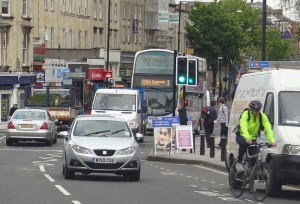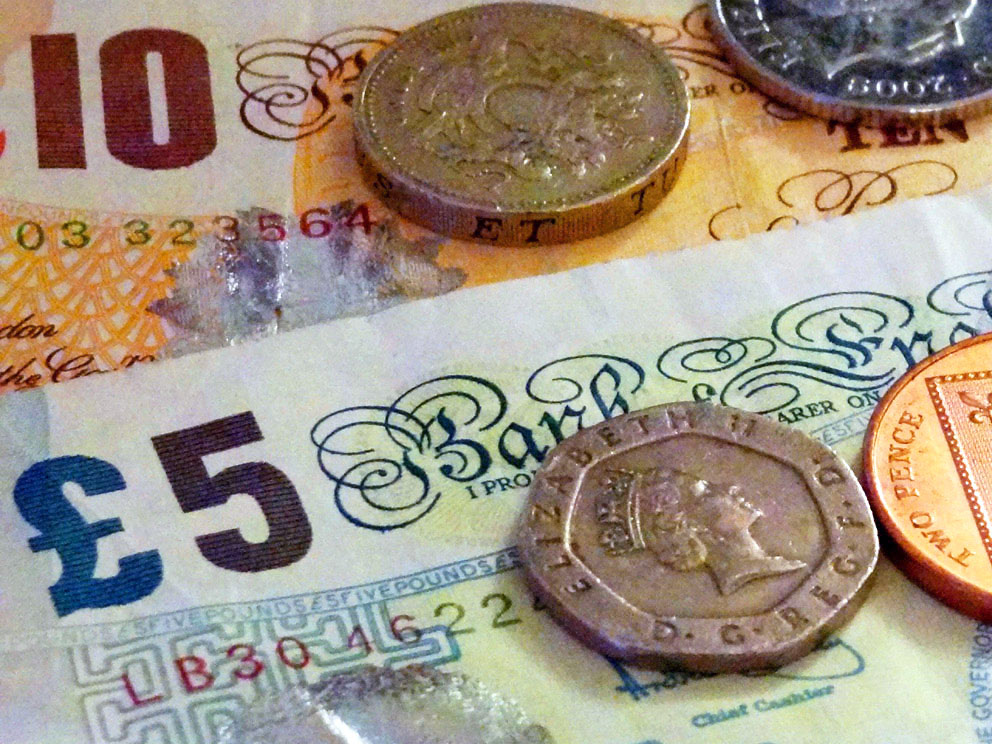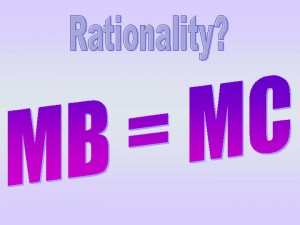 Previous posts on this blog have discussed key principles of thinking like an economist and also whether this always makes sense. Highly relevant for this question, on her excellent Economists do it with models blog, Jodi Beggs has recently highlighted the fact that the cognitive costs of obtaining the information required to make decisions in this way can sometimes be excessive.
Previous posts on this blog have discussed key principles of thinking like an economist and also whether this always makes sense. Highly relevant for this question, on her excellent Economists do it with models blog, Jodi Beggs has recently highlighted the fact that the cognitive costs of obtaining the information required to make decisions in this way can sometimes be excessive.
As an example she cites this scenario from the Cheap talk blog:
“You are planning a nice dinner and are shopping for the necessary groceries. After having already passed the green onions you are reminded that you actually need green onions upon discovering exactly that vegetable, in a bunch, bagged, and apparently abandoned by another shopper. Do you grab the bag before you or turn around and go out of your way to select your own bunch?”
I won’t go through the details of the 12 steps (see the above link) taken to infer from where the onions were abandoned that they were either:
“the best onions in the store and therefore poisoned, or they are worse than some onions back in the big pile but then those are poisoned.”
Based on this inference, the conclusion is that you should go for a take-away instead! As Beggs suggests, the level of effort undertaken to make a decision should depend upon the likelihood that this results in a more informed choice. In the above example this is highly questionable! She then provides the following example suggesting that when you obtain cash back in a store it is much better to ask for the money in small denomination notes. Whilst on face value this again seems like a strange conclusion, the economic logic provided suggests that it may be a much more rational decision than in the onion example.
Article
Just for fun: reasons not to data an economist (thanks guys)…Economists do it with models, Jodi Beggs (25/10/12)
Questions
- Can you provide some examples of decisions where the cognitive costs of obtaining relevant information is very high?
- In these examples, would this information typically result in a better decision?
- What might be the opportunity cost of shopping in the manner described in the article?
- Explain how a rational economic actor should evaluate whether to obtain more information in order to facilitate making a decision.
- The article above suggests that there are a number of benefits from requesting small denomination notes, but what might be the costs involved in this strategy?
 Everyone who drives in the UK is required to take out car insurance. Whilst fully comprehensive is voluntary, it is compulsory to have at least third party insurance, which covers damage to other vehicles. Insurance premiums are calculated based on a number of different variables, such that two people driving the same car may face wildly different costs.
Everyone who drives in the UK is required to take out car insurance. Whilst fully comprehensive is voluntary, it is compulsory to have at least third party insurance, which covers damage to other vehicles. Insurance premiums are calculated based on a number of different variables, such that two people driving the same car may face wildly different costs.
Although there are many insurance companies to choose from, this industry has been referred to the Competition Commission by the OFT as it was ‘worried the structure of the market was making costs and premiums unnecessarily high.’
According to Moneysupermarket, the average cost of car insurance reached a high of £554 in April 2011, but have fallen by £76 since. With tight incomes across the UK for many families, high car insurance premiums is another strain and thus this investigation will come at an apt time, even though the findings of the CC may not be reported for 2 years. The Association of British Insurers (ABI) said that the investigation would:
‘bring much-needed reforms to the market that will, in turn, result in lower car insurance premiums for consumers’.
 The problem seems to be that when an individual is involved in an accident and sends their car off for repairs, their insurance company doesn’t have much control over the bills they end up paying, which can be inflated by £155 each time. This therefore leads into higher costs for the insurance company, which are then passed on the driver in the form of an increased premium. Other concerns were that courtesy cars were being offered, at an estimated cost of £560 per vehicle (according to the OFT) and that drivers were using these cars for longer than necessary, once again causing costs to rise.
The problem seems to be that when an individual is involved in an accident and sends their car off for repairs, their insurance company doesn’t have much control over the bills they end up paying, which can be inflated by £155 each time. This therefore leads into higher costs for the insurance company, which are then passed on the driver in the form of an increased premium. Other concerns were that courtesy cars were being offered, at an estimated cost of £560 per vehicle (according to the OFT) and that drivers were using these cars for longer than necessary, once again causing costs to rise.
Altogether, it has been suggested that the actions of the insurance company of ‘not-at-fault’ drivers, car hire companies, repairers and brokers push up the prices for ‘at-fault’ drivers’ insurance companies. Given that any insurance company is just as likely to be the ‘at-fault’ insurance company, they all face rising costs.
 Back in May, the OFT had already decided that the car insurance market required a more detailed investigation, because of the ‘dysfunctionality’ of the market. Following a public consultation, the industry will now face an investigation by the CC. One additional area that may be of interest to the CC came to light last year, where it was found that insurance companies were claiming against themselves in a bid to drive up premiums. Although the investigation will take some time, it is still a timely review for many drivers, who have seen the cost of motoring reach record highs. The following articles consider the market for car insurance.
Back in May, the OFT had already decided that the car insurance market required a more detailed investigation, because of the ‘dysfunctionality’ of the market. Following a public consultation, the industry will now face an investigation by the CC. One additional area that may be of interest to the CC came to light last year, where it was found that insurance companies were claiming against themselves in a bid to drive up premiums. Although the investigation will take some time, it is still a timely review for many drivers, who have seen the cost of motoring reach record highs. The following articles consider the market for car insurance.
Articles
Car insurance market referred to Competition Commission BBC News (28/9/12)
No quick fix for motor insurance abuses, says watchdog Independent, Simon Read (29/9/12)
Car insurance industry faces probe The Press Association (28/9/12)
Competition Commission referral will take time to lower motor insurance premiums The Telegraph, Rosie Murray-West (28/9/12)
UK car insurance probe over-shadows Direct Line IPO Reuters, Matt Scuffham and Myles Neligan (28/9/12)
 Car insurance scrutinized over high premiums Sky News (28/9/12)
Car insurance scrutinized over high premiums Sky News (28/9/12)
Rip-off motor insurance firms face competition watchdogs probe over £225million racket Mail Online, Ray Massey (28/9/12)
Questions
- Why are car insurance firms willing to take on other people’s risks?
- What conditions must exist in a market for private companies to provide acr insurance (or insurance of any kind)?
- Why is third-party insurance compulsory, whereas people can opt for fully comprehensive insurance?
- What powers does (a) the OFT and (b) the Competition Commission have? Is it likely that this report will have any impact on car insurance premiums?
- What allegations have been made that help to explain why insurance premiums I this industry have increased?
- Is there an argument for allowing the industry itself to provide its own regulation?
- In which market structure would you place the car insurance industry?
 A recent article on this blog discussed the likelihood that we will soon move to a cashless society. It is therefore interesting to consider the implications that this might have for consumer behaviour. We might expect the form of payment to make no difference to a rational consumer. However, there is considerable evidence to suggest that this is not the case.
A recent article on this blog discussed the likelihood that we will soon move to a cashless society. It is therefore interesting to consider the implications that this might have for consumer behaviour. We might expect the form of payment to make no difference to a rational consumer. However, there is considerable evidence to suggest that this is not the case.
One reason why people appear to spend more freely on credit cards is payment decoupling – you get utility from the item purchased before you pay the cost. However, more recent evidence suggests that this is not the only relevant factor. It appears that the degree of transparency of the payment method also has an effect. Psychologists quoted in the above article conclude from their experimental evidence that:
Payment modes differ in the transparency with which individuals can feel the outflow of money. ….with cash being the most transparent payment mode.
This effect also appears to make people spend cash less freely.
 The author of the above article spent some time experimenting with trying to make all his purchases using cash. He found that by doing so, he was able to reduce his spending by about 10%. However, this seems likely to become harder to do in the future and, as the article concludes, it is already difficult to purchase some items with cash.
The author of the above article spent some time experimenting with trying to make all his purchases using cash. He found that by doing so, he was able to reduce his spending by about 10%. However, this seems likely to become harder to do in the future and, as the article concludes, it is already difficult to purchase some items with cash.
Article
Why does foreign money seem like play money? Science Codex (04/06/07)
Questions
- What type of products is it already difficult to purchase with cash?
- How did the psychologists test the transparency of payment methods?
- Do you think the consumer behaviour described above is likely to persist in the long-run?
- Might firms be able to take advantage of the consumers behave described above?
- Do you think the transparency of foreign currencies is the main reason why people spend more when they are abroad?
 A key economic principle is that rational decision making requires thinking at the margin. This involves a comparison of the additional (or marginal) benefits and costs of an activity.
A key economic principle is that rational decision making requires thinking at the margin. This involves a comparison of the additional (or marginal) benefits and costs of an activity.
An example of such rational behaviour would be deciding to drink one more beer or spending one more hour studying only if the additional benefits were greater than the additional costs. The optimum is where marginal benefit equals marginal cost.
And this applies to firms too. A firm maximises its profits by producing the output at which marginal revenue is equal to marginal cost.
 However, a recent book by the American business guru Clayton Christensen argues that thinking in this way can be a problem. A recent article in the Guardian describes a story he tells of the time he refused to play for his university basketball team in a national final which took place on a Sunday and therefore conflicted with his religious beliefs. His decision involved sticking to his principles rather than thinking at the margin. For him, whilst the marginal cost of sacrificing these principles just once may well have been small compared to the resulting benefits, the eventual cost would be much higher.
However, a recent book by the American business guru Clayton Christensen argues that thinking in this way can be a problem. A recent article in the Guardian describes a story he tells of the time he refused to play for his university basketball team in a national final which took place on a Sunday and therefore conflicted with his religious beliefs. His decision involved sticking to his principles rather than thinking at the margin. For him, whilst the marginal cost of sacrificing these principles just once may well have been small compared to the resulting benefits, the eventual cost would be much higher.
Christensen also suggests that similar arguments can apply to firm decision making. The above article provides an example he uses of decisions made by executives at the Blockbuster video chain. When smaller rivals started offering movies by mail, Blockbuster instead continued to invest in its existing video store business model. This eventually proved disastrous for the company. The explanation given for this is that building on previous investments made more sense than setting up a mail-order arm which would cannibalise their existing business. On the other hand, an alternative explanation may be that executives at Blockbuster were irrationally allowing sunk costs to affect their decision making.
Articles
Clayton Christensen’s “How Will You Measure Your Life?” Harvard Business School, Clayton Christensen (9/5/12)
Clay Christensen’s life lessons BloombergBusinessweek, Bradford Wieners (3/5/12)
Bust Blockbuster goes on the block Guardian, Ben Child (4/4/11)
Questions
- Can you think of a situation where you have decided to stick to your principles rather than think at the margin?
- Why does a firm maximise profit by producing the output at which marginal revenue is equal to marginal cost?
- What do you think are the main costs of setting up a mail-order business?
- Are these costs mainly fixed or variable costs?
- Why is it irrational to take sunk costs into account when making a decision?
- Can you think of a situation where you have been influenced by sunk costs?
 A recent post on this blog referred to what sounds a fascinating new book, What Money Can’t Buy: The Moral Limits Of Markets, by Michael Sandel. The Guardian also recently featured an extract from this book.
A recent post on this blog referred to what sounds a fascinating new book, What Money Can’t Buy: The Moral Limits Of Markets, by Michael Sandel. The Guardian also recently featured an extract from this book.
As the earlier blog post discussed, our lives are now dominated by markets. Economists typically believe markets are the best way to allocate resources as, if the market mechanism works correctly, the resulting equilibrium maximizes economic welfare as measured by the sum of consumer and producer surplus. In particular, all consumers that are willing to pay a price above the market price are able to buy the product.
Fundamental to the measurement of consumer welfare is the notion that consumers will be prepared to buy a product as long as their willingness to pay exceeds the price. It therefore follows that consumers are more likely to buy the product as the price falls and, if they do so, gain increasing surplus. However, the extract from Michael Sandel’s book provides a number of interesting examples which suggest that in some situations this might not be the case.
 One example concerns the storage of nuclear waste in Switzerland. When surveyed, 51% of the residents of the small Swiss village of Wolfenschiessen, said that they would be prepared to accept the waste being stored nearby. However, somewhat surprisingly, this figure fell to 25% when the residents were told that they would be compensated for the inconvenience. Furthermore, the figure remained at this low level even when the proposed compensation was increased to over £5000 per person.
One example concerns the storage of nuclear waste in Switzerland. When surveyed, 51% of the residents of the small Swiss village of Wolfenschiessen, said that they would be prepared to accept the waste being stored nearby. However, somewhat surprisingly, this figure fell to 25% when the residents were told that they would be compensated for the inconvenience. Furthermore, the figure remained at this low level even when the proposed compensation was increased to over £5000 per person.
Sandel argues that this is because, once compensation is introduced, financial incentives crowd out public spirit. He suggests that:
putting a price on the good things in life can corrupt them.
For economists, this potentially has important implications for how we evaluate market outcomes and our belief that the market equilibrium is always the optimal outcome. Furthermore, it suggests that in some circumstances allowing the market mechanism to allocate resources may not be the ideal solution.
Articles
What money can’t buy – review The Guardian, John Lanchester (17/05/12)
Michael Sandel: ‘We need to reason about how to value our bodies, human dignity, teaching and learning’ The Guardian, Decca Aitkenhead (27/5/12)
We must decide on the way we want to live now London Evening Standard, Matthew d’Ancona (23/05/12)
Questions
- How is consumer surplus calculated?
- How does the market mechanism allocate resources?
- How would you explain the responses of the residents in the Swiss village?
- Do you think the Swiss residents would respond in the same way if the compensation offered was increased even further?
- What type of products and services do you think might be less well suited to being provided by markets?
 Previous posts on this blog have discussed key principles of thinking like an economist and also whether this always makes sense. Highly relevant for this question, on her excellent Economists do it with models blog, Jodi Beggs has recently highlighted the fact that the cognitive costs of obtaining the information required to make decisions in this way can sometimes be excessive.
Previous posts on this blog have discussed key principles of thinking like an economist and also whether this always makes sense. Highly relevant for this question, on her excellent Economists do it with models blog, Jodi Beggs has recently highlighted the fact that the cognitive costs of obtaining the information required to make decisions in this way can sometimes be excessive.








